Lifestyle
Planning a Dreamy Destination Wedding? These 5 Indian Resorts Offer Intimate Elegance with Unbeatable Scenic Views
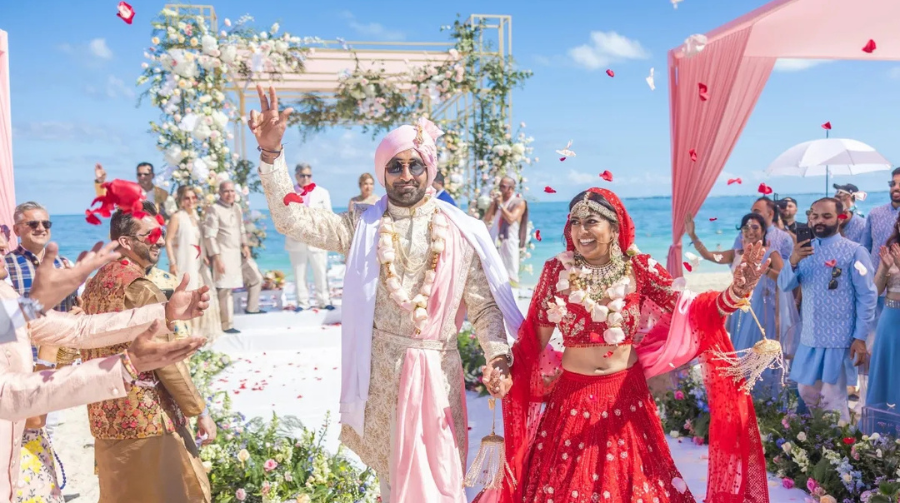
Why Intimate Destination Weddings Are on the Rise
As modern couples look for more personal, picturesque, and peaceful wedding experiences, intimate destination weddings have become the new gold standard. Think: exchanging vows on a cliff with the Arabian Sea behind you, or saying “I do” amid misty Himalayan peaks.
The trend? Fewer guests, more luxury, and stunning backdrops.
Let’s explore five Indian resorts that deliver exactly that—perfect for couples looking to host an unforgettable wedding with under 150 guests in attendance.
The Oberoi Udaivilas, Udaipur (Rajasthan)
A royal romance by the lake
Often ranked as one of the most beautiful hotels in the world, The Oberoi Udaivilas is a dream come true for couples seeking grandeur in intimacy. Situated on the tranquil banks of Lake Pichola, this palace-style resort fuses traditional Rajasthani charm with opulent modernity.
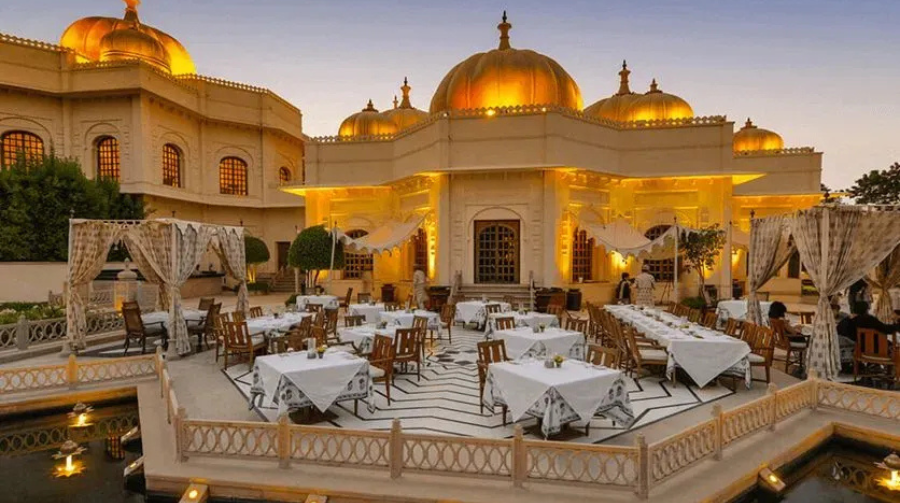
JW Marriott Walnut Grove, Mussoorie (Uttarakhand)
Whispered vows in the clouds
Tucked away in the Queen of Hills, this luxurious mountain resort offers an enchanting alpine escape. With panoramic Himalayan views and wooden lodge-style interiors, it provides the perfect fairytale ambiance for hill lovers.
Why It Works for Intimate Weddings:
- The Wisteria Deck is ideal for small hilltop ceremonies
- Cozy indoor banquet for mehndi or sangeet
- Spa & wellness area for guest pampering
Ideal For:
Nature-loving couples who want a cloud-kissed celebration
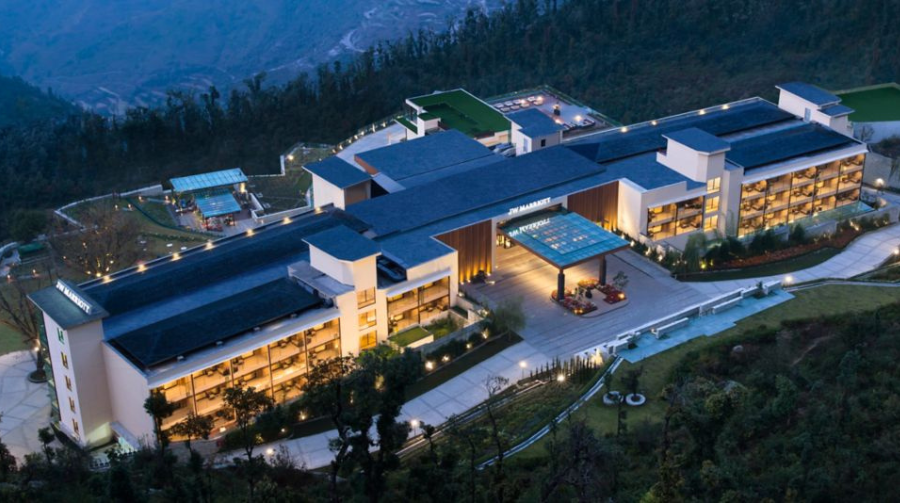
Fountain IHCL SeleQtions, Mahabaleshwar (Maharashtra)
Strawberry fields and forever after
Set amidst 27 acres of forested land, this colonial-style property in Mahabaleshwar offers a laid-back but luxurious wedding escape. It boasts stunning valley views, temperate weather, and botanical charm.
Why It Works for Intimate Weddings:
- Outdoor gardens with vintage arches and fairy lights
- Nearby strawberry farms for fun pre-wedding shoots
- Compact but charming interiors for functions
Ideal For:
Couples seeking a nostalgic yet contemporary mountain wedding
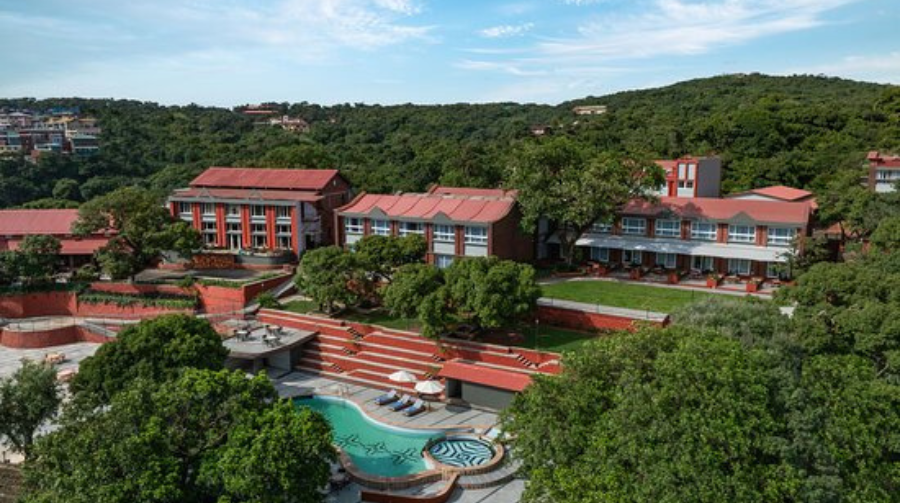
The Leela Kovalam, Kerala
A cliff, a sunset, and a vow
This clifftop resort facing the Arabian Sea is one of Kerala’s finest luxury properties. With a breathtaking coastal view and soothing sea breeze, it’s perfect for couples dreaming of a beach wedding without the crowd.
Why It Works for Intimate Weddings:
- Mandap on the Sunset Deck overlooking the sea
- Traditional Kerala Sadya options
- Private spa treatments and Ayurvedic therapies
Ideal For:
Couples who want a peaceful oceanfront wedding with local cultural touch
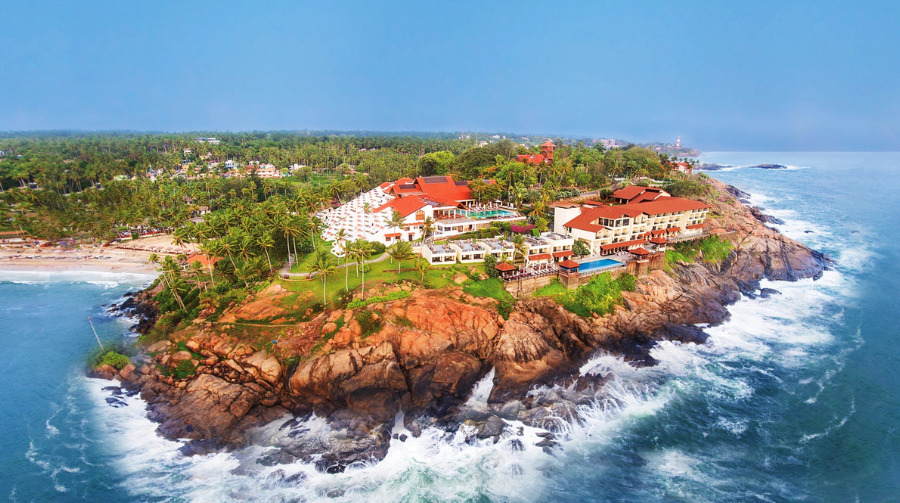
Moksha Himalaya Spa Resort, Kasauli (Himachal Pradesh)
Romance meets wellness in the clouds
Only accessible via a scenic cable car ride, this resort combines wellness, privacy, and Himalayan vistas in one unbeatable package. It’s a serene escape for couples who prefer a holistic, stress-free celebration.
🌿 Why It Works for Intimate Weddings:
- Outdoor forest terrace for ceremonies
- Eco-luxury with wood cabins and spa rooms
- Romantic infinity pool views
✨ Ideal For:
Minimalist couples looking for nature, luxury, and peace
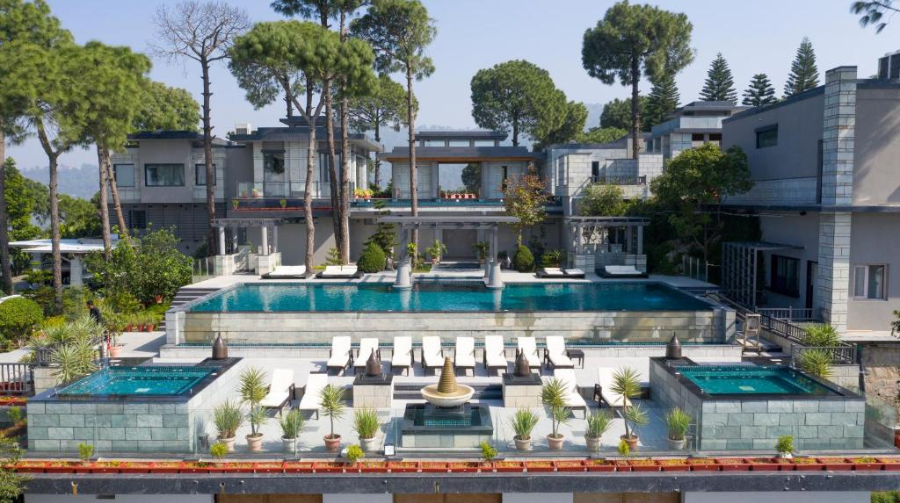
Planning Notes: How to Make It Work
Here are a few key considerations when planning a destination wedding at these resorts:
When to Book
- October to March: Best weather for Udaipur, Mahabaleshwar, Mussoorie
- November to February: Ideal for Kerala and Himachal to avoid monsoons
Guest Count
- Ideal Range: 40–100 guests
- Choose resorts with dedicated wedding coordinators
Budget Tips
- Intimate weddings can be luxurious under ₹20–30 lakhs
- Resorts offer wedding packages with accommodation, décor, and dining bundled
Photo Magic
- Sunrise/sunset time slots for golden hour portraits
- Use backdrops like Lake Pichola, Himalayan decks, and sea cliffs
Comparison Snapshot
| Resort | Region | Max Guests | Highlight | Best Season |
|---|---|---|---|---|
| The Oberoi Udaivilas | Udaipur | 100 | Palace + Lake vibe | Oct–Mar |
| JW Marriott Mussoorie | Mussoorie | 80–100 | Hilltop luxury & spa | Apr–Jul |
| Fountain SeleQtions | Mahabaleshwar | 100–120 | Colonial charm + valley views | Oct–May |
| Leela Kovalam | Kerala | 50–70 | Clifftop seaside with Ayurveda | Nov–Feb |
| Moksha Himalaya Resort | Kasauli | 40–80 | Gondola access & wellness vibe | Oct–Mar |
Final Thoughts
From palatial grandeur to tranquil cliffside serenity, these Indian resorts offer the best of intimacy, scenery, and tradition for your big day. Whether you’re envisioning a small beach mandap or a forest-themed pheras, each resort brings something magical to the table.
And best of all? No compromise on luxury, just fewer guests and deeper moments.
Beauty
🌸 Viral Skincare Trends: What Works and What’s Overhyped? A Dermatologist Breaks It Down
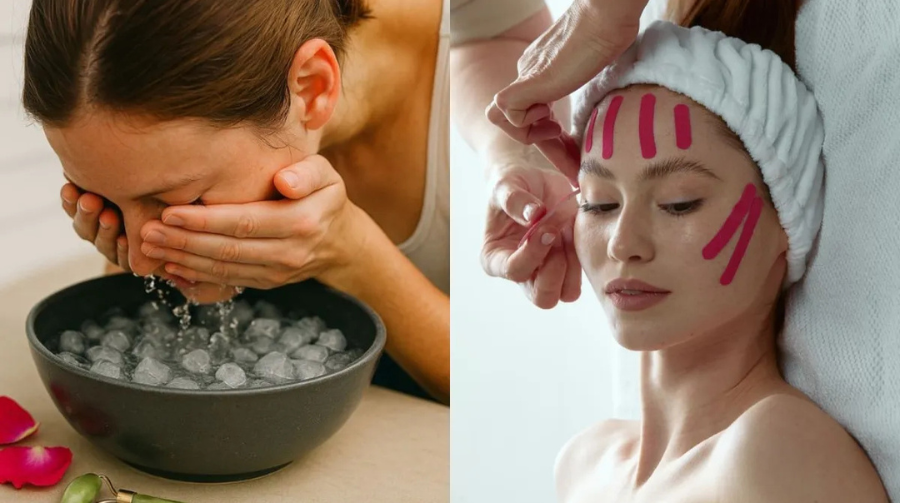
Social media is flooded with skincare trends — from “slugging” to “skin cycling.” But do they actually work? Dr (Major) Gurveen Waraich rates six of the most viral beauty hacks to reveal what’s worth your time and what’s just hype.
The world of skincare is constantly evolving, with TikTok, Instagram, and YouTube serving as breeding grounds for viral beauty hacks. From dipping your face in ice water to layering thick ointments at night, these trends often promise glowing, youthful skin — but not all deliver.
To separate fact from fad, dermatologist Dr (Major) Gurveen Waraich shared her expert take on six of the most talked-about skincare and haircare trends dominating social media right now.
🧊 1. Ice Face Dipping (Rating: 5/10)
The trend: Submerging your face in ice water for a few seconds to tighten pores and reduce puffiness.
What the expert says:
Dr Waraich confirms it can temporarily improve circulation, reduce morning puffiness, and make skin look fresher. However, she warns that these effects are short-lived and purely cosmetic. Overuse can even irritate sensitive skin or worsen rosacea.
Takeaway:
✅ Works as a quick refresh
🚫 No long-term benefits
Pro tip: Use a cold compress or chilled jade roller for similar effects with less mess.
💧 2. Slugging (Rating: 7/10)
The trend: Applying a thick layer of petroleum jelly (like Vaseline) as the final step in your nighttime routine to “lock in” moisture.
What the expert says:
Dr Waraich recommends slugging for people with dry, dehydrated, or sensitive skin. It effectively prevents transepidermal water loss, helping the skin barrier recover.
However, those with oily or acne-prone skin should approach carefully — it can clog pores or worsen breakouts.
Takeaway:
✅ Great for dry skin or barrier repair
🚫 Risky for oily/acne-prone types
Pro tip: Try a thin layer over moisturiser instead of full-face slugging.
🌿 3. Rosemary Oil for Hair (Rating: 4/10)
The trend: Massaging rosemary oil into the scalp to promote hair growth.
What the expert says:
While some studies hint at rosemary oil improving scalp circulation, Dr Waraich stresses that scientific proof remains limited. Any benefits are likely modest and slow to appear.
Takeaway:
✅ Safe when diluted properly
🚫 Results vary; not a miracle oil
Pro tip: Use a few drops mixed with carrier oil (like coconut or jojoba), and avoid applying it directly to the scalp.
🔄 4. Skin Cycling (Rating: 10/10)
The trend: Rotating skincare actives—using retinoids one night, exfoliants the next, and recovery products afterward—to balance results and barrier protection.
What the expert says:
Dr Waraich calls this “the most balanced routine” for active users. It allows skin time to heal and rebuild, preventing irritation from overuse of potent ingredients.
Takeaway:
✅ Effective for all skin types
✅ Scientifically sound and dermatologist-approved
Pro tip: A simple 4-night cycle:
- Night 1: Exfoliate (AHA/BHA)
- Night 2: Retinoid
- Night 3 & 4: Recovery (hydration + barrier support)
🎭 5. Face Taping (Rating: 0/10)
The trend: Applying adhesive tapes to “train” skin and reduce wrinkles overnight.
What the expert says:
Dr Waraich strongly advises against it. The adhesive can irritate, tear delicate facial skin, and damage the protective barrier — potentially accelerating aging instead of reversing it.
Takeaway:
🚫 Gimmick, not science
🚫 May cause irritation or micro-tears
Pro tip: Instead, invest in gentle facial massages or retinol-based products to improve firmness safely.
🌾 6. Rice Water for Skin (Rating: 6/10)
The trend: Using water from soaked or boiled rice as a natural toner or rinse.
What the expert says:
Rice water contains antioxidants and soothing compounds. Though scientific data is limited, many find it calming and hydrating — especially for sensitive or irritated skin.
Takeaway:
✅ Gentle and safe for most skin types
🚫 Limited scientific backing
Pro tip: Refrigerate rice water for 24 hours and use it as a toner or mask base for a refreshing DIY treatment.
🌟 Final Verdict: Expert Summary
| Trend | Rating | Verdict |
|---|---|---|
| Ice Face Dipping | 5/10 | Refreshing but temporary |
| Slugging | 7/10 | Great for dry skin |
| Rosemary Oil for Hair | 4/10 | Mild results |
| Skin Cycling | 10/10 | Scientifically sound |
| Face Taping | 0/10 | Avoid completely |
| Rice Water | 6/10 | Gentle, but limited proof |
👩⚕️ Expert’s Closing Thoughts
She also advises consulting a certified dermatologist before introducing new actives or DIY remedies, especially if you have sensitive, acne-prone, or reactive skin.
Beauty
Paris Fashion Week: Aishwarya Rai Stuns in Diamond-Studded Manish Malhotra Sherwani

Aishwarya Rai Bachchan once again proved why she is regarded as a global fashion icon, as she walked the ramp at Le Défilé L’Oréal during Paris Fashion Week 2025. Dressed in a diamond-studded sherwani designed by ace couturier Manish Malhotra, Aishwarya brought Bollywood’s timeless elegance to one of the biggest international fashion stages.
The sherwani was not just a garment but a cultural statement—an androgynous couture piece that married Indian heritage with Parisian high fashion. Studded with diamond detailing, embroidered with precision, and styled with dramatic cuffs, the outfit struck the perfect balance between ornament and armour.
A Couture Moment that Paused Paris
Paris is no stranger to spectacle, but Aishwarya’s appearance was more than just a show—it was a cultural handshake between India and global couture. The sherwani’s diamond-studded embroidery glittered under the runway lights, reminiscent of starlight scattered across the night sky. The back of the sherwani featured cascading scalloped diamond motifs, a subtle nod to the nau lakha haar, seamlessly integrated into the design rather than treated as an accessory.
This wasn’t fashion as clothing; it was fashion as storytelling—a translation of Indian craftsmanship for a global audience. The audience’s reaction was telling: applause, stunned silence, and a wave of adoration across social media.

Manish Malhotra’s Vision
Designer Manish Malhotra, who has long championed Indian aesthetics on global platforms, described the look as a fusion of heritage and modernity. His design philosophy with this sherwani was to celebrate the regality of Indian attire while presenting it in a fresh, fearless form suitable for Paris’s avant-garde runway.
On his social media, Malhotra shared behind-the-scenes glimpses of the look, which quickly went viral. Fashion critics across the globe hailed the creation as a couture masterclass that blurred the line between jewellery and clothing.
Beauty that Complemented the Couture
Aishwarya’s beauty look was understated yet powerful, allowing the sherwani to command attention. Her hair flowed in soft, natural waves, framing her face without stealing focus from the couture. The makeup palette leaned toward earthy glam—dewy foundation, sculpted cheekbones, and a pop of bold red lipstick. Her eyes carried a perfect balance of shimmer and sharp liner, bringing a touch of drama without overwhelming the look.
This careful styling reflected the runway strategy: restraint paired with statement, heritage merged with modern glamour.
Why This Walk Matters
For Aishwarya Rai, this was more than just a fashion appearance. It was a global reassertion of Indian couture on one of the most influential runways in the world. Her walk demonstrated that tradition, when presented with conviction, is not static—it evolves, inspires, and challenges expectations.
In a fashion industry often chasing novelty, Aishwarya reminded everyone that true style lies in timeless storytelling. Her sherwani was not simply worn; it was performed—making Paris Fashion Week 2025 a moment that will be remembered in the annals of both Bollywood glamour and international fashion.
Festivals
Navratri 2025: Devotees throng temples across India as nine-day festival begins | Videos

The nine-day Sharadiya Navratri festival began today with grand celebrations across India, as devotees gathered in temples to worship Goddess Durga and her nine divine forms. The auspicious festival, which symbolizes the triumph of good over evil, is marked with prayers, fasting, and cultural festivities such as Garba and Dandiya.
Devotees throng temples across India
From Delhi to Mumbai and Madhya Pradesh, temples were filled with spiritual fervor on the first day of Navratri 2025.
- Delhi: Large crowds gathered at Kalkaji Temple, Jhandewalan Temple, and the Shree Adya Katyayani Shaktipeeth Mandir in Chhatarpur, where morning aarti was offered with chants and devotional hymns.
- Mumbai: The historic Mumbadevi Temple witnessed the sacred Kakad Aarti ceremony, a traditional ritual marking the beginning of festivities.
- Madhya Pradesh: Thousands of devotees visited the famous Maa Baglamukhi Temple in Nalkheda, Agar Malwa district, believed to have links to the Mahabharata era, adding to its spiritual significance.

The significance of Navratri
Navratri is one of Hinduism’s most sacred and vibrant festivals, dedicated to worshipping the nine forms of Goddess Durga, collectively known as Navdurga. Each day is devoted to a different form of the Goddess, symbolizing aspects such as strength, courage, purity, wisdom, and compassion.
This year, Navratri begins with Ghatasthapana and the worship of Maa Shailputri on September 22, 2025, and will conclude on Vijayadashami (Dussehra) on October 2, 2025.
Devotees observe fasts (vrat), install a kalash at home or temples during shubh muhurat, chant mantras, and perform aarti seeking blessings for prosperity, health, and spiritual strength.
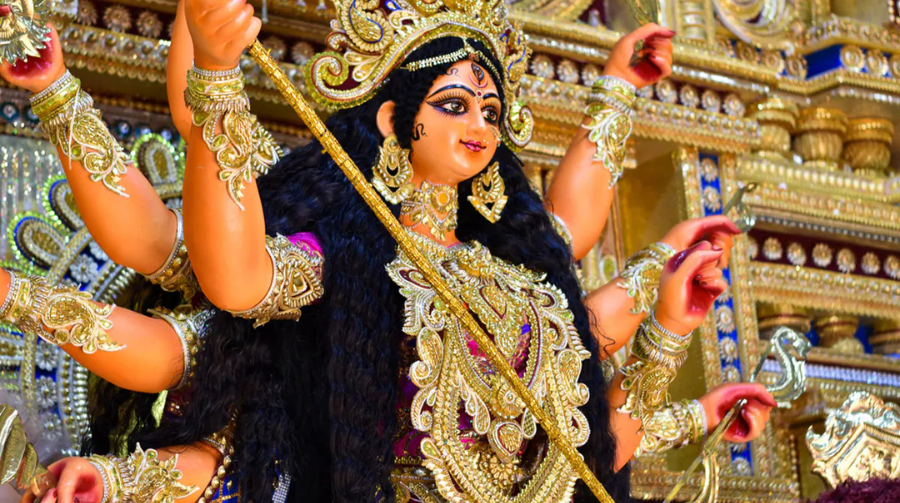
Navratri traditions and celebrations
- Fasting & Puja: Devotees abstain from grains and non-vegetarian food, offering fruits, sweets, and special vrat meals to the Goddess.
- Cultural festivities: In Gujarat and Maharashtra, traditional Garba and Dandiya nights bring communities together with colourful attire, music, and dance.
- Durga Puja Pandals: In West Bengal and eastern India, grand Durga Puja pandals are set up with artistic idols of Maa Durga, attracting lakhs of devotees.

A festival of unity and devotion
Navratri transcends regions, blending spirituality with cultural celebration. From the Himalayas to the coastal temples of South India, the Goddess is invoked with devotion and splendour, making Navratri not just a religious occasion but also a festival of togetherness, joy, and cultural pride.
-

 Celebrity Lifestyle6 months ago
Celebrity Lifestyle6 months agoEx-Cricketer Shikhar Dhawan Buys Ultra-Luxury Apartment Worth ₹69 Crore in Gurugram
-

 Glamour & Entertainment5 months ago
Glamour & Entertainment5 months agoTelegram Channels Disseminating Pro‑Russian Propaganda in Poland
-
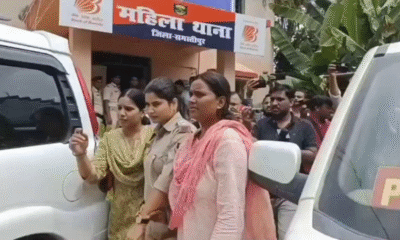
 Crime & Investigation3 months ago
Crime & Investigation3 months agoDelhi Police SI Neetu Bisht Caught Taking ₹20 Lakh Bribe – Shocking Details Emerge in Corruption Probe
-

 Business5 months ago
Business5 months agoAmazon sets 30‑day relocation deadline for corporate staff—opt out by resigning in 60 days
-

 Celebrity Lifestyle5 months ago
Celebrity Lifestyle5 months agoMaha Kumbh Girl Monalisa seen in car allegedly worth ₹1 crore
-

 Entertainment5 months ago
Entertainment5 months agoAbhijeet & Dr Tarika Reunite in CID 2 — Fans Say ‘Clear the Misunderstanding Now
-

 Education5 months ago
Education5 months agoNEET UG Controversy Explained: Paper Leak, Impersonations & Ongoing Probe
-

 Bollywood3 months ago
Bollywood3 months agoNo ₹3 Lakh Fine or 2-Year Jail: The Truth Behind the ‘Hakla’ GIF Buzz




